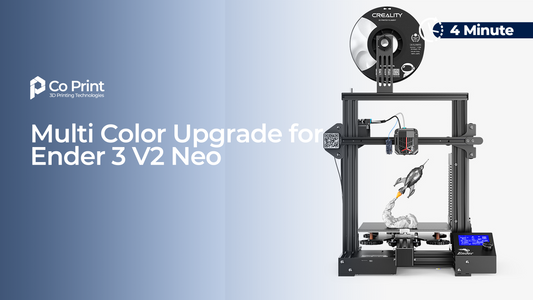In FDM technology, when creating multi-colored or multi-material 3D prints, the cleaning tower (also referred to as the Transition or Wipe Tower) plays a significant role. This tower aids in cleaning the extruder between filament transitions, ensuring distinct separations in the model. However, the primary drawback for users is the filament waste that the cleaning tower generates. Co Print's multi-filament 3D printing module, which allows the use of up to 7 filaments in a single print, necessitates a cleaning tower. Pioneers of multi-filament printing like Palette and MMU, or newcomers such as BambuLab AMS, also experience waste ratios similar or even greater than the Co Print Multi-Filament Module.
Why is Filament Waste Necessary?
Multi-filament prints require a "cleaning" phase when transitioning between different colors or materials. This cleaning phase ensures the expulsion of any leftover filament in the extruder from the previous material. This waste material constitutes the cleaning tower.
What Happens Without the Cleaning Tower?
Without using a cleaning tower, there's a risk of the extruder not being fully cleared during filament transitions. This can lead to several issues:
- Degraded Print Quality: Without a complete cleaning during transitions, unwanted blending of colors can occur.
- Filament Flow Issues: If the old filament isn't entirely cleared, it can obstruct the flow of the new filament, leading to printing errors.
- Increased Printing Errors: Without a cleaning process, filament transitions can cause excess or insufficient material in certain parts of the print.

Ways to Reduce Filament Waste from the Cleaning Tower

Having explained the logic behind the cleaning tower in Co Print's multi-filament 3D printing module and other similar solutions, let's delve into how to minimize filament waste using certain features in slicing software.

Optimize Transition Settings
The first step to reduce filament waste is to adjust the transition length. This represents the amount of material used when transitioning between filaments. By reducing this value, your extruder can use less material, resulting in a smaller cleaning tower. But be cautious; reducing it too much can compromise print quality. For instance, transitions between contrasting colors like black and white require a higher transition ratio.
Transition Within the Infill Option
Another smart solution to functionally reduce the cleaning tower is to opt for transitions within the infill. While this doesn't eliminate the cleaning tower entirely, it prefers to conduct transitions within the infill. For models with a high infill volume, this method significantly reduces waste. An area of the model that remains unseen takes the place of the cleaning tower.
Print Multiple Models
One of the most innovative methods to prevent filament wastage is to print multiple identical models in a single session. Instead of producing a usually functionless rectangular prism as the cleaning tower, the same or a different model can be printed. Functional parts where the surface color isn't a concern are an intelligent choice for this method.
Optimize Transitions with Model Placement
If there are color changes in a specific area of the model and the rest of the model remains a single color, positioning the model so that all transitions occur at the beginning of the print can reduce the tower size. The function of the cleaning tower ends after a specific height, just like a standard single filament print.
Increase Layer Heights
Increasing layer height can effectively reduce the size of the cleaning tower. Especially for models with large surfaces, raising layer height can yield efficient results in reducing filament wastage.
In Conclusion
The Co Print multi-filament 3D printing module and similar solutions require a cleaning tower to ensure the highest quality multi-filament 3D print output. While there are disadvantages like extended printing time and filament wastage, the above methods can minimize these drawbacks. For more information, please refer to our wiki section or contact us.




